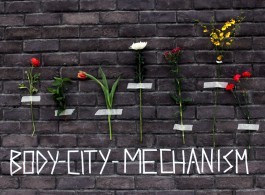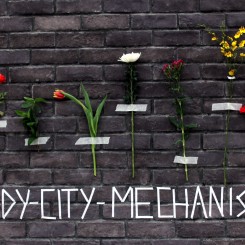Press Release
Body-City-Mechanism
The Liu Dao collective has always been fascinated with the ability of technology to come alive, to move and to interact with a lively vigor. And with its fingers firmly on the pulse of Shanghai, island6’s newest exhibition,Body-City-Mechanism, explores not only the vital signs of our city but the ability of it to take a life, and perhaps a personality, of its own. Please join us on April 25th for our 52nd exhibition at our m50 home for a multimedia delight exploring ideas of urban growth, biological design and metropolitan identity through a series of interactive artworks and installations.
Cities have always been likened to living organisms—Plato talked about the city as a corporeal body— and the urban spaces we’ve created have come to resemble their creators. Structurally, they follow a distinctly biological design and obey the same metabolic laws that govern every organism. Culturally, a city is just a body writ large that is rooted in the habits and customs of those that inhabit it. It is here from which the city takes on a sense of moral as well as physical organization, which mold and modify one another in melodic and biological rhythm. Perhaps it isthe structure of the city that first envelops and seizes us with its visual vastness and complexity. But inside that structure and beneath its ever-growing skyline, lives a world pulsing with activity and life.
As Bio-mimicry surrounds us, many urban systems exhibit a palpable vibrancy much like organic life. If Fritz Kahn’s iconic drawings of the human body modeled after industrial machines were to be reversed, they would instead show a machine, a city, that functions like the human body. Electricity pulsing like blood through power lines. Cars and trucks winding down the branching vesicular roads, delivering nourishment and materials to extended limbs. Cranes and forklifts working with ceaseless energy as they build and regenerate building after bone, each one taller and stronger than the last. Factories spurt our clouded air while they manufacture food to fuel an unending appetite. Cellular signals and Internet cloud-based control systems send important messages and data, behaving much like a virtual urban nervous system. The city moves.
Below the skin and under the street lie the intestines, the metal guts that allow suburbs to sprawl and skyscrapers to rise. Fiber-optic cables are nerves, and the metro tunnels are its thick jugular veins. Energy is consumed and waste is produced. An impervious, animalistic heat escapes from the grates in the street, a foul breath that soaks the city in its haze. There is a quiet pulse- the unhurried swoosh of anonymous liquids, punctuated every now and then by the rumble of a metro train. The mechanical pumps and pistons keep a steady beat, like a rusted heart. The city seems alive.
While such metaphors of nature’s laws shape our sense of cities, they don’t force us into a static view. We see each city, and we see Shanghai, as part of a dynamic ecosystem, a singular evolutionary matrix and like every living creature, it has a genetic code. This is expressed through architectural styles, landmarks and spatial characteristics, through art, cultural histories and people- the DNA of the urban environment. As the “father of modern anthropology”, Claude Levi-Strauss, beautifully stated “By its form as by the manner of its birth, the city has elements at once of biological procreation, organic evolution and aesthetic creation. It is both a natural object and a thing to be cultivated; individual and group; something lived and something dreamed.”† The identity of a city is created and nurtured by the stories and ideas of those that have lived and journeyed through it, collectively and perpetually giving it new life, anima, and character; a timeless evolving poem.
Just like living creatures, cities grow, change and decay. They expand and consume and even take on personalities and identities of their own. It is the collective shaping of character that pushed Shanghai from the “Whore of the Orient” to its reigning Queen status. Even the architecture speaks of both eras, holding on to and resembling the city’s vast memory and consciousness, while eagerly and proudly displaying her new, shiny crown. The walls between the past and present are porous; the golden days of bygone Shanghai have not yet vanished. However, if too much of the past is lost, the architectural heritage and cognizance is destroyed and the city’s communal memory of its unique identity is violated. The double helix of Shanghai would be altered perhaps resembling the great Metropolis of the Fritz Lang film, a tech noir of the Anthropogenic era or a Baudrillard-esque simulation.
Cities are not static objects, but active arenas marked by continuous energy flow and transformation of which landscape, building and technology are not permanent structures but transitional manifestations. Flux, systematic interactions and metabolic exchanges now determine the geography of a new urban individuality, a city as body. Like a biological organism, the urbanized landscape is an open system, forever changing and flickering like the lights on an LED screen though just as delicate and natural as our Jianzhi (剪纸) and rice paper illuminations. Continuing with Liu Dao’s affinity towards technological flair and innovation using state of the art LED, photography, video, animation, sculpture and interactive artwork, Body-City-Mechanism, is an exploration into the personality, vitality and ability of our city, the Queen of the Orient, to exist, flourish, and to resemble life on her own.
Curation: Margaret Johnson
Art Direction: Thomas Charvériat
Scenographer: Fabrice Amzel, Jean Le Guyader
Research: Cecilia Garcia, Nick Mithen, Guan Yan 官彦, Melani Murkovic
Music: David Keohane
Coordination: Yeung Sin Ching 杨倩菁
Artists: island6 art collective (Liu Dao六岛)


